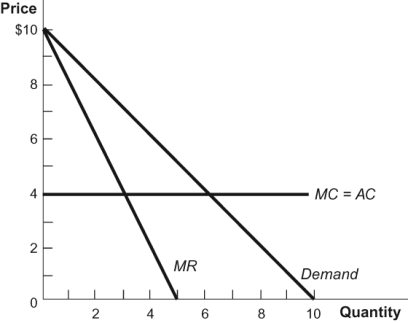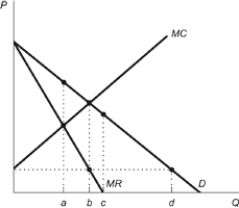A) the deadweight loss will be eliminated as output expands to its efficient level.
B) consumer surplus will expand as prices fall.
C) the deadweight loss will increase as there are now more lost gains from trade.
D) consumer surplus is eliminated and the deadweight loss is maximized.
Correct Answer

verified
Correct Answer
verified
Multiple Choice
HP ties its printer ink to its printers by embedding a patented printer head in its ink cartridge rather than build it into the printer. This raises the cost of producing the ink cartridge. If the government passed a law requiring HP ink be used with HP printers, would this law increase or decrease deadweight loss?
A) decrease
B) increase
C) no change
D) impossible to say
Correct Answer

verified
Correct Answer
verified
Multiple Choice
Why are patients who suffer from rare terminal diseases more likely to die if the cost of new drug development is about the same for rare and more common terminal diseases?
A) Federal regulations require that drugs for common diseases get developed before drugs for rare diseases.
B) The market is larger for more common diseases,- and so it is more likely drugs would be developed for the common diseases.
C) Drug firms practice perfect price discrimination.
D) Drugs for rare and common diseases can be sold as bundled goods.
Correct Answer

verified
Correct Answer
verified
Multiple Choice
Bundling increases ________ and hence increases the incentives to ________.
A) costs; innovate
B) profits; innovate
C) revenue; price higher
D) demand; enhance customer service
Correct Answer

verified
Correct Answer
verified
Multiple Choice
Figure: Price-Discriminating Monopolist 3  Refer to the figure. Profit for the single-price monopoly in this diagram is ______, and under perfect price discrimination, profit is ______.
Refer to the figure. Profit for the single-price monopoly in this diagram is ______, and under perfect price discrimination, profit is ______.
A) $9; $24
B) $18; $24
C) $4.50; $18
D) $15; $12
Correct Answer

verified
Correct Answer
verified
Multiple Choice
Pharmaceuticals with high fixed costs can benefit with the practice of price discrimination because:
A) high fixed costs create incentive for pharmaceuticals to sell more.
B) charging different prices to different customers generates different levels of fixed costs.
C) profit from customers paying high prices allows pharmaceuticals to cover part of the fixed costs.
D) extra profit from customers paying low prices allows pharmaceuticals to cover part of the fixed costs.
Correct Answer

verified
Correct Answer
verified
Multiple Choice
Pfizer sells Atgam in New Zealand for $14 per pill and in Brazil for $8 per pill. This implies that the demand curve in New Zealand must be ________ than in Brazil.
A) more inelastic
B) less inelastic
C) more elastic
D) closer to perfectly elastic
Correct Answer

verified
Correct Answer
verified
True/False
Monopolists that are able to perfectly price discriminate generate the most deadweight losses.
Correct Answer

verified
Correct Answer
verified
True/False
Price discrimination discourages innovation and new product development in industries with high fixed costs.
Correct Answer

verified
Correct Answer
verified
Multiple Choice
Use the following to answer questions:
Figure: PPD  -(Figure: PPD) Refer to the figure. Which of the following statements best explains why a firm that perfectly price discriminates would sell additional units beyond a units of output?
-(Figure: PPD) Refer to the figure. Which of the following statements best explains why a firm that perfectly price discriminates would sell additional units beyond a units of output?
A) A firm will not sell beyond a units of output. The firm will only sell exactly a, as it is the profit-maximizing rate of output for this firm.
B) The marginal cost is less than consumers' willingness to pay for these units.
C) The marginal cost is greater than consumers' willingness to pay for these units.
D) A firm will not sell beyond a units of output, since the marginal cost is greater than the marginal revenue for these units.
Correct Answer

verified
Correct Answer
verified
Multiple Choice
Bundling can increase efficiency especially when:
A) both fixed costs and marginal costs are high.
B) both fixed costs and marginal costs are low.
C) fixed costs are high and marginal costs are low.
D) fixed costs are low and marginal costs are high.
Correct Answer

verified
Correct Answer
verified
Multiple Choice
A perfectly price-discriminating monopoly causes:
A) no social surplus.
B) maximum social surplus.
C) as much social surplus as in the case of a standard monopoly.
D) as much social surplus as in the case of monopolistic competition.
Correct Answer

verified
Correct Answer
verified
Multiple Choice
Movie theaters typically price discriminate by charging ______ a lower price than ______.
A) men; women
B) women; men
C) senior citizens; young adults
D) young adults; senior citizens
Correct Answer

verified
Correct Answer
verified
Multiple Choice
Price discrimination is considered bad when ________, but good when ________.
A) it increases output; it decreases output
B) it decreases output; it increases output
C) it increases deadweight loss; it decreases deadweight loss
D) it increases prices; it decreases prices
Correct Answer

verified
Correct Answer
verified
Multiple Choice
Why are seniors charged less for coffee at McDonald's than younger people?
A) McDonald's wants to avoid ageism lawsuits.
B) McDonald's earns higher profits by charging seniors less.
C) McDonald's discovered that younger people have a more elastic demand for coffee than seniors.
D) McDonald's respects the elderly.
Correct Answer

verified
Correct Answer
verified
True/False
To price discriminate, firms must identify a customer's or a group of customers' willingness to pay.
Correct Answer

verified
Correct Answer
verified
True/False
Tying is a legal strategy, but bundling is illegal in the United States.
Correct Answer

verified
Correct Answer
verified
Multiple Choice
Some bars host a "ladies' night," on which women get drinks free or at a discount. Aside from differing elasticities of demand, why might bars want to charge a lower price to women than to men?
A) It is difficult to arbitrage drinks.
B) An increased quantity of drinks sold to women will attract male customers.
C) An increased quantity of drinks sold to men will attract female customers.
D) Men cost less to serve than women do.
Correct Answer

verified
Correct Answer
verified
Multiple Choice
Bundling is expected to provide greater profits when the two bundled goods are: I. substitutes. II. goods that have high fixed costs and low marginal costs. III. very close complements.
A) I only
B) II only
C) II and III only
D) I, II, and III
Correct Answer

verified
Correct Answer
verified
True/False
Arbitrage makes it more difficult for firms to practice price discrimination.
Correct Answer

verified
Correct Answer
verified
Showing 121 - 140 of 262
Related Exams